Vithinja
This article is considered abandoned lore either because its creator has changed projects or has left the community. Accordingly, it is not only non-canon but it is also eligible for salvage pending approval from an administrator.
|
Viþinjske Samwärckens Köningsrigge Zyndicatist (Ruþí) Viþjinsk | |
|---|---|
|
Flag | |
Motto: 'Fhremodt imot himmlvägnen' 'Forwards towards heavens road' | |
Anthem:
| |
| Capital | Rolvsvik |
| Largest | Tår Bringär |
| Official languages | Ruthi |
| Recognised national languages | Ruthi, Siarvish |
| Recognised regional languages | Caeric |
| Ethnic groups (2025) |
|
| Religion |
|
| Demonym(s) | Ruthan, Ruthie |
| Government | Unitary Syndicated Constitutional Monarchy |
• King | Rolv XI Sortvit |
| Rolv XI Sortvit | |
| Magnus Tornsson | |
| Rikart Ragnersson | |
| Sten Vikqvist | |
| Ingrid Fridsdotr | |
| Riordan Mayor | |
| Lina Birgitdotr | |
| Area | |
• Total | 1,099,191 km2 (424,400 sq mi) (rank here) |
• Water (%) | 6.83% |
| Population | |
• 2028 estimate | 70,900,000 58,000,000 full citizens |
• 2027 census | 70,442,491 |
• Density | 61.1/km2 (158.2/sq mi) |
| GDP (nominal) | estimate |
• Total | $3,662,103,641,565.74 $3.662 trillion |
• Per capita | $51,987.14 |
| Gini (2027) | low |
| HDI (2027) | very high |
| Currency | Ruthan korunmärck (ʍ) |
• Summer (DST) | UTC+0 |
| Date format | yy-mm-dd |
| Driving side | left |
| Calling code | +61 |
The Syndical Cooperative Kingdom of Vithinja (Ruþí: Viþjinsk) often simply referred to as The Cooperative is a constitutional monarchy located in Kiro-Borealis, but can geopolitically be considered connected to the Levantian region of Northern Ultmar and it's various nations. Sitting at the connection between the Kilikas Sea and the Sea of Nordska it is joined by Caergwynn in the south among the vithinjan island chain. Crossing the Kilikas Sea to the far west lies the island-continent nation of Kiravia, heading southward instead one finds the lands of Faneria. Vithinja holds the only land crossing from Kiroborea to Levantia via the Bringär-Awraidd Bridging Project, a large set of bridges and underwater tunnels connecting the Kiroborea mainland to most of the Vithinjan isles and ending in northern Caergwynn. The Vithinjan capital is the city of Rolvsvik, despite being only the 7th largest city in the nation. Rolvsvik holds importance as the historical seat of power of the various royal lines of the nation as well as being the religious center for the Church of Rolv. The two largest cities are Tår Bringär and Cärssund, both of which lie within the vithinjan isles. Tår Bringär has long been the economic capital of Vithinja as it holds a large and deep natural harbor well placed for both safety and trading purposes. For most of Ultmar history the city benefited from strategically defensible geography, avoiding devastation from the many wars that plagued the Ultmar mainlanders, but since the great war it has fallen in favor somewhat compared to these mainland harbor cities. Vithinja has a population of ~70 million people. The vast majority of the population lives either in the vithinjan isles, or the more temperate southern coastline, but the northern lakes region still holds small population centers. These northern population centers are important to help extract the large wealth of the northern lands.
Vithinja is a nation reborn many a times until it's modern day state. It's latest reshaping being the Syndicalization, an event only 80 years old. On the other hand the culture and traditions of a united northern nation has existed for almost a millennium. One of that nations largest issues is caused by large variety in cultures, religion, traditions and more recently ideologies, combined with a strong willed politically active populous, leading to the nation never truly being able to achieve stability. The nations origins is a tale of two very different peoples fighting each other for the reign but almost always united against foreign threats. The first traces of the two groups arriving in the north date back as far as 700 CE. From the evidence they were not the first people to live in the Vithinjan lands but whatever natives came before are long extinct. It is believed that the first group of settlers who would become the Ruthans left their homeland in western Levantia to sail for new lands in the north, while the celtic origins are even less certain. Both peoples started settling many of the islands along the northern coast of Levantia as well as finding the lands of Ruthinja. While the Ruthan people have generally been the rulers over both peoples the Guerigogled have almost always outnumbered them, to the confusion of many scholars.
The vithinjan population is mainly divided into the Ruthans, the former ruling people as well as the Guerigogled (Ruþí: Gärgöthe, Siarvish: Siargogle) often shortened to Guerigs, who make up the majority of the population. While they once had huge cultural differences the two cultures are well integrated together in the modern era, making religion and ideology the more common cause of cultural differences than ethnicity
While not being a very populous country, thanks to a combination of large quantities of natural resources with a high security for companies to extract them today, as well as good shared control of the northern Levantian maritime trade together with Caergwynn, the Vithinjan people are quite well of. Maritime trade is especially secured thanks to the city of Tår Bringär, which holds the deepest and among the largest harbors in Ultmar trade.
Vithinja is a part of the League of Nations and the Kilikas-Boreal Cooperative Zone.
History
Main Article: History of Vithinja
Noborean Settlers
Noborea was once settled by some native culture that there are little remnants of, with so little evidence of their existence leaving room for people to consider that they may have been celts, geats or even coscovians. They were practically extinct by the year 1000, with their numbers never having exceeded fifty thousand at their largest expanse by most estimate. The modern people living in Noborea and most of the Vithinjan Isles came sometime in the 8th century from two separate origins. These origins are surrounded by myths and legends, but thanks in part to a few more reliable records made by the group some suspect to be the origin group for the Caerics. What is known for certain is that the Nogeaths who settled western Noborea came from the north western coast of Ultmar, somewhere west of Faneria. Meanwhile, the origins of the Gogauls who settled eastern Noborea is more uncertain, but are believed to have emigrated from settlements along one of the major rivers of modern Fiannria or the lands to it’s east. These settlements are also a possible origin point for the Caerics, explaining the cultures great similarities. It is believed that the Gogauls arrived at least 25 years earlier, and were the dominant culture group in most of Noborea for at least 100 years, thanks in part to their ability to settle the best lands. This was especially true for the Vithinjan Isles, which remained almost exclusively celtic for 300 years, only starting to gain a proper Nogeath minority after The Viking Contentment Period really got going.
Thanks to the mixing of the seafaring culture of these two migrant groups after many decades of tribal conflicts, the consolidation of smaller tribes into larger ones and general population growth the peoples of the north, especially those living on the Noborea mainland started to run into a simple but motivating scarcity: A near total lack of a stable food source. While some agriculture could be maintained and the both fresh-and saltwater fish were plentiful, the fish was not nearly enough to survive on alone and the harvests were incredibly variable depending on how harsh the harsh the years winter ended up being. These factors would all lead to a region-defining cultural shift that would spread from the west-most Nogeaths all the way to the east-most Gogaul: The raiding of far away, wealthier lands. Although most early raiding was done internally, the harsh resistance that was often met combined with lacking resources worth stealing lead raiders to start sailing further and further. By the early 800’s they idea of sailing south, to lands inhabited by much weaker and richer peoples started spreading like wildfire, in part thanks to the seafaring leading to a strong interconnectivity among the northern tribes. Based on the Nogeath title for one of these seafarers a new threat started to menace far beyond their Noborean homes: The Vikings.
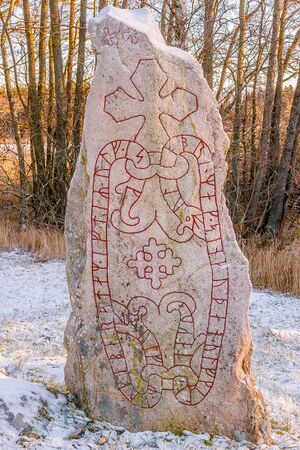
The Viking Age
The Viking Age commonly refers to a time between 800-1300 and is generally broken up into five periods, The Reaver Period, The Invasion Period, The Consolidation Period, The Viking Golden Age and finally The Viking Contentment Period. While each of these hold a massive amount of history within them, we will only shortly discuss the most imporant aspects of each here.
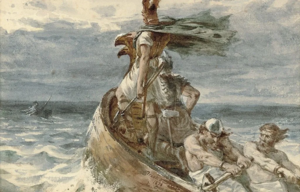
The Reaver Period (~810-950) is named after the main term used for the viking raiders by the northern successor kingdoms of the Holy Levantine Empire. This period is mainly defined by the fast and vast expansion of raided areas. Throughout mid to late 800’s the vikings went from raiding along the nearby modern Fanerian north coast and among the island of modern Sorhaithe to targetting the entire North Ultmar coast, and travelling far along the rivers into the Ultmar mainland. While raiding a number of raiders set up conquered viking realms, with the largest of these period being the first of the Reaver kingdoms, settling along the coast running eastward from Noborea. Despite the vikings of this period remaining relatively decentralized it still saw a slow centralization of power. This took it’s final shape in between the 910’s and 950’s when a number of so-called viking lords rose to power, maintaining the fealty of vast numbers of tribes among large territories. The nature of these tribal federations were however still very decentralized, leading to modern historians usually not referring to these realms as tribal kingdoms. In the end, what finally ended up causing the next large-scale change among the viking cultures was, ironically, the exact same issue that started their marauding ways: All the new resources that they had successfully plundered and brought back lead to prosperity in their homelands, which caused a population boom that tripled their population over the course of the century. A great tribal chieftain who had united most of the western Ruthan tribes caused this next great change, by announcing, preparing and leaving their homelands at a massive scale, in a huge migration to conquer and settle the more prosperous lands their raiding peoples already dominated.
The Invasion Period (890-1220) is empathized by the many migrations and new realms the Vikings created and maintained across large sections of Ultmar, even if most by the 17th century would be some combination of integrated into the local cultures, slowly fade in comparison to larger local cultures or simply be subjugated and expelled. These migrations would however lead to a strong bond between the Noboreans and North Levantines, both economically and politically. Even in the modern day viking descended cultures outnumber the entire modern Vithinjan population. The main cause of viking migrations fading was a mixture of improvements to defensive engineering in Ultmar as well as simply having less free lands to target and many Viking realms that were already well settled and fiercely aggressive against competitors. This also caused the slow start of the Contentment Period, which would start to vastly change the cultural idea of what a Viking was among the Noborean cultures.
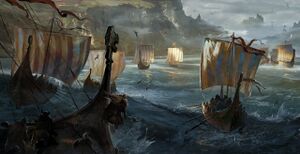
The Consolidation Period (980-1330) coincides quite substantially with the invasion period, in part because it was a result of the response to these invasion in different parts of the world. This period can be separated between The Christian Consolidation, The Ruthinjan Unification and the Ultmar Viking Wars. The Christian Consolidation started with the arrival and success of Caergwynn, one of the most vital rival powers in Vithinjan history. Through the use of a powerful navy and a well centralized highly militarized realm so close to the viking homeland the Caerics successfully pressured many concessions and treaties from the various viking tribes north of them. Although some attempts were made at both subjugation and devastation the Caric knights quickly found that the best relations they could hope for were tributes and allies, as the northern Viking cultures could not easily be quelled or destroyed. This forced the viking raiders to travel farther and target new regions, which helped to find new targets for the Viking migratory invasion as well. This consolidation was further worsened thanks to a combination of the successfully revitalized realm of Cuhlfros in addition to a number of stronger tribal federations forming along the western side of Northern Ultmar. The Ruthinjan Unification describes the rise of The first unified kingdom in Noborea. It also saw the real first step for christianity spreading into Noborea, with the new Ruthinjan kingdom being formed by the first Viking Lord to ever baptise himself. He could howevernever put an end to the marauding traditions of his people.
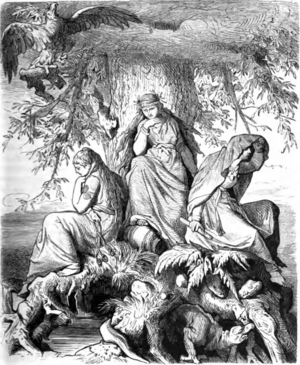
Ultmar Viking Wars includes a number of wars among the various ultmari Viking realms as well as many bordering realms which lead to the destruction or consolidation of most of these regions into new kingdoms. Through the combination of these factors almost all the lands that were once the prime targets for their raids now became mostly inaccessible. This would lead to two great changes that once more redirected Viking history: More advanced seafaring techniques that allowed the raiders to venture far beyon the local region together with the and a shift in the power balance in the Noborean region away from the Vithinjan heartlands towards the north Ultmar riverlands. These two changes along with many other factors would birth the Viking Golden Age.
The Viking Golden Age (1100-1275) would see almost all the greatest achievements among the Viking cultures in exploration, architecture, art, science and dominance. These Would include the first Levantine discovery of Koskovina and great Kirav as well as an expedition that is thought to have reached Soirwind. It would also see the first Vikings reaching the southern city of Urceopolis. It would be the start of standardized raiding in the Vandarch as one of the main targets of Viking raids. The Vikings would also settle numerous islands including Insul Weiss, Vonein, Eryksisle and numerous others. In the end however, these longer distance expeditions together with most other civilisations greatly improving at defending against their raids would lead to the death of the old Viking profession, replaced by a new Viking: One who was well known and respected not just among the Noborea cultures but among most of Ultmar and parts of Levantia... As far-going tradesman. Some believe that the ideas for the highly interconnected trade empire That Burgundie successfully achieved took their founding ideas from these trading Vikings and perfected it.
The Contentment Period (1220-1505) represents the slowly progressing change among Vikings away from large-scale conquest, raiding of large settlements and migratory invasions. They would instead turn to in some part smaller scale piracy but mainly they would become the largest part of the merchant class in north Ultmar, never truly being replaced even though they were later to a large degree implemented into the Burgundine merchant empire.
- The Noborea-Ultmar Templar Wars
The Noborea-Ultmar Templar Wars, also known as the Noborea Irae, covers a period between 1200-1500, where a combination of factors lead to large scale conflicts between the northern pagans and Christians, which later turned to a series of conflicts between the old traditional regimes and the new divinely guided holy orders. The final results of these wars was a partial shift towards more absolutist ideas, the large-scale conversion of most pagans, the establishment of Vithinja and Caergwynn as the two main powers north of the Empire and the rejection of the Pope as the leader of the Christian faith in the region.
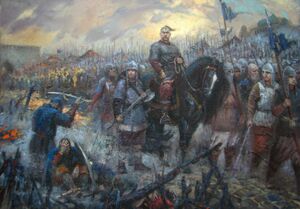
Ultmar Crusade was started in the 12th century by the kingdom of Cuhlfros, supported by a number of more southern holy orders. However it did not truly reach Noborea until the start of the 13th. This first Noborean crusade was a massive failure, as the Crusaders could not make up for the superiority of pagan seafaring in a region defined by land barriers and islands. It was not helped that the strange threat from the south proved that the Viking realms were not as divided as thought, as many of them, especially those from the Borea mainland, would ally together against the southern incursion. Most of the Latin crusaders chose to focus on fighting along the rivers of the Vandarch after this failure. The few that didn't mainly turned to the more local northern christian elements of Caergwynn and Cuhlfros, hoping to learn how to fight a foe whose tactics were foreign to them.
For the remainder of the first half of the 13th century there would only be a few smaller conflicts in the region, but this would all change in the 1260's. After the emergence of the Caergwynn republic, there was a huge upheaval when one of the largest Viking realms converted to Christianity and allied with the Caeric knights. This alliance suddenly dramatically changed the power balance of the region, and not soon after Caergwynn attacked the last remnant of those Vikings who would claim half his realm. This escalated into a series of wars now known as the Caeric-Viking Holy Wars.
- Caeric-Viking Holy Wars
These wars started with the war for Hogripmar in 1267, which was the remains of the kingdom that ones held almost all of Caergwynns territories. This declaration of war was responded to by the kings of Ruthalvrigar and Clipprigar, the two most powerful pagan viking realms at the time, who both declared war on Caergwynn. Their new ally, the former viking realm of Havengem, would support the Caerics against their fellow Nogeaths. This war would last into the first months of 1270, leading to a clear Caeric victory on the mainland, annexing Hogripmar. There were a few other smaller secession but with few border changes. This would be known as the First Caeric-Viking War, and would serve as a meager taste of the bloodshed to come.
The perceived aggression after this war would cause support from some of the less involved Viking realms, such as Anenmarigar and Sudabruda. The following war, the Second Caeric-Viking War, was declared by Clipprigar in 1279 to take back the lands formerly held by Hogripmar, which were seen as important pagan lands. This war would escalate to include in practice the entire north excluding the Nordskans. For the first two years the war was a vicious defensive grind for the Caerics and their allies, facing a substantially more numerous and wealthier foe. In 1281 things would change however, as the former pagan kingdom of Aurdicania would Christianize mid war, and declare on Ruthalvrigar, causing the first major war on the Borea mainland in history. This would start to change the tide of war, but it was not until 1283 when the king in Cuhlfros joined to assist their fellow Christians that the pagans would be driven back. Not only did they join the war, but a second northern crusade was declared. With the arrivals of the Latin support through out 1280 they would reverse most of the occupations of the Vikings. In mid 1284 a treaty was made, one that would change the region dramatically. While there were a few territories handed to some of the Viking realms, for the most part the war saw large regions of pagan lands, especially among their fortified islands, handed over to the victors. Although most of these were technically vassals of either Caergwynn or Cuhlfros, most of them were granted to the holy orders who had fought for them, who turned out to be quite loose vassals.
The Third Caeric-Viking War would serve to show what the new status qua of the regions should be. In 1295 Clipprigar would declare war on Caergwynn to take back their lost island territories. This time Cuhlfros would end up not taking part, as their own holy order vassals disobedience strained relations. The war only lasted until 1298, but ended up being vastly more destructive than the second war, especially for the Viking island territories. This time there would be no mercy for the Viking realms, who were beaten badly. The holy orders would take for themselves substantial territories, even demanding any and all territories that may have been given to Caergwynn. While the war was the greatest Christian success so far it would also serve as the start of a rift between the Caerics and the Latin holy orders.
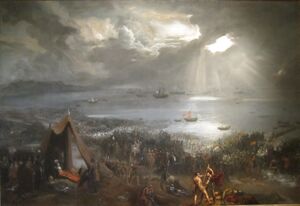
Templar Consolidation
At the start of the 14th century the newly arisen templar lead nations in the Noborean region started acting much more independently of their sponsor nations. A series of smaller border wars ended up being fought between them and their neighbors allowing them to expand further. By 1320 they would make a monumental decision: they attacked Caergwynns old ally Havengem. This caused a war between the Caerics and the templar, which ended with the templars taking Havengems island holdings. This war served mainly to sour the relations between the various Christians in the region and the foreign templar orders. The following 20 years saw much fewer conflicts, with much of the region trying to recover from the many years of war.
At the same time the Noborean realms were busy fighting internally, with the Ruthinjan region weakened by the previous 50 years of holy wars and the Nordskan decedent kingdoms of Anenmarigar and Havengem under attack, power started to shift towards the Borean Nordskan kingdom, which unified for the first time. They would fight a war against the Ruthinjan lords and win, allowing them to get a footing in the Vithinjan islands for the first time.
With the arrival of 1350 the Great Plague ended up hitting Levantia hard. One of the most important effects of this was the reduction in reinforcements for the templar orders, forcing them to become more aristocratic and levy troops from local populations. These troops mainly came from the local celts, although those with close connections toward the Caerics were often found to be almost as reluctant as the viking descendants. Meanwhile, the pagans of Nordska saw a monumental change, in part because of the rumors of the distant plague striking the Christians. They would reject the Christian feudal institutions that had helped elevate Ruthinja 200 years earlier, and instead look to the ideas of holy warriors fighting for the divine. This would lead to the Judgement of Lords, where a group of tribal leaders would declare war on their own ruling class, overthrowing them and instituting a militaristic holy order, who would become known as the Valkeer.
Angelic Wrath Wars
With the establishment of the Valkeer and the Templar in the region, the next 100 years would be some of the bloodiest the region had ever seen. While the various smaller holy realms countless wars against each other could be compiled separately most simply consider the next 50 years to be a single huge war between these holy orders. Ironically enough Caergwynn would end up being a wildcard during this era, fighting both against and together with both Templars and Valkeers, which allowed them to stay powerful as the two would never work together to destroy the princely republic. These wars would indirectly be one of the main causes for the Viking Contentment, as they prevented further migrations, reduced the number of raiders leaving the homelands and forced most of the colonial viking realms to fend for themselves, leading to most either being toppled or substantially weakened. Most of the smaller realms in the area would be consolidated into six remaining powerful realms in the region: Caergwynn, Aurdicania, The Transmarian Order, The Vitruthavalkeer, The Arforia Order and Anemarigar. This would all be changed by something that had yet to happen in the entire regions history: the rise of gothic-celtic realm in Borea.
The history surrounding Rolv I Sorthänd is surrounded by myths and legends, making the facts of the era hard to track. There is reasonable evidence that Rolv was the son of a Caeric templar officer in under the Transmarians Order and a ruthan Valkyrian. He would grow up in the order for the first seven years of his life before his mother was able to escape with him back to Ruthinja. Because of the strange circumstances of his heritage and upbringing he would find himself in a crisis of faith, attempting to fit both the ideals of Christendom and Nordskan paganism together. In his teens he would suddenly leave his family behind, traveling aimlessly for a few years before finding himself in Aurdicania. Through a series of uncertain events he would find himself becoming an commander for the celtic nation, critically just as Aurdicania was dragged into the Angelic Wrath wars once more. Rolv would find himself commanding an army against one lead by his own father at the battle of Vorgsborg, where he would seek out his father and face him in single combat. He would best his father, Cumain Gwynllaw, leaving the man at his mercy. While he would spare him, he would symbolically cut off his fathers main hand, a pristine white gauntlet covering it that represented not only his noble family but had come to be one of the main symbols for the Transmarian order. After this Rolv would paint the same gauntlet black and wear it for the rest of his life, letting it become his own symbol, giving both him and all his decendants their family name: Sorthänd, or Blackhand.
All of this happened in large part thanks to the scheming of the rulers of Aurdicania and Caergwynn, who secretly made a pact that would spell the end of the destructive holy war. They both allied together with the Templars to finally deal a definitive defeat to the Valkeer. This war took seven bloody years but would see the Vitruthavalkeer almost completely pushed out of the islands back into Borea. This was not the end of the celtic scheme however, as the two allied nations immedietly proceeded to declare war on the templars. During the war with the Valkeer they had kept back and limited the damage to themselves, placing themselves strategically to defend the templars lands as the templars themselves assaulted the pagans. The sudden betrayal of their former allies would substantially weaken the Templar orders, but they would still prove a tough opponent. After 15 years of war, they were finally defeated, with Rolv being born exactly a year before the war started.
Rolv would lead his armies, taking substantial land from the Templars for Aurdicania. When the peace was finally made, Rolv would himself take a large part in the negotiations, demanding that he himself be given a substantial dukedom and the title of marquize of the southern isles. While this would spell the end of the Angelic Wrath Wars, it was only the beginning of what would become the Sorthänd legacy.
The Founding of Vithinja
Rolv successfully goes from small duke to ruler of the entire Vithinjan isles. He dies young but his son would with the help of Rolvs brother unite all of Noborea under one crown. Late in his life he would formally found the Church of Rolv.
Noborean Imperialism
Vithinja starts interfering in Northern Levantia, especially the Kilikas coastline. Vithinjan relations with Caergwynn are hostile.
The Anarchy happens, Vithinja and Caergwynn end up on the same side unexpectedly and are able to protect the north from Catholic dominance, in large parts thanks to naval dominance. During the war Vithinja and Caergwynn together declare themselves the Protectors of Luthers Will.
Vithinja takes control/influence of Kilikas coastline. This would later lead to Vithinja being dragged into some of the Tundra wars against Faneria. First Kin War happens, Vithinja takes some small part but mostly just uses its navy to blockade Faneria. West Vandarch War finally crushes most of what is left of Vithinjan influence on the Kilikas coastline, leaving little left of the Vithinjan empire. Second Kin War was last chance for Vithinja to recover the empire. They fail.
The Borean Twin Republic
As a result of the First boreal war Vithinja loses the last of their empire and the main line of the royal family dies out. This leads to a Personal Union with Caergwynn as the major partner.
The 100 years of history when the Borean Twin Republic existed was the most peaceful and one of the most prosperous periods in Vithinjan history. From this it has received another name: The Unforgotten Peace. Many have attributed this peace to the sharing of policies with the more peace-minded Caerics.
Thanks to the many years of peace this period saw the dawning of a relatively new part of the Vithinjan nation: a scientific sector, largely inspired by similar institutions that already existed within Caergwynn. This lead to a golden age of discoveries in Vithinja.
This unprecedented period of peace would end when what would become the First Great War broke out between Kiravia and Burgundie. With both sides long having been an important trade partner to Vithinja, but a closer alliance being established with Burgundie more recently as well as a fear of Kiravian claims on the vital island of Nordlän, the Borean Republic reluctantly joined the war on Burgundies side. The war would not see much fighting for the Vithinjan army, with not a single battle being fought on borean territory. However, the most important impact of the war on the republic was the near total destruction of the navy, requireing years to rebuild it into a competent fighting force. The war would end with huge changes to many other nations, but nothing was really gained nor lost by the republic. At the very least peace had returned. It would not last long.
Only a year after the First Great War, Faneria would declare war to take a large portion of Caergwynns western territories, as well as possibly seizing the Vithinjan straight. This war would come to be called the Borean War, a large-scale conflict that lasted for three years and saw the near total collapse of the republican army, as well as the first ever conflict where Vithinja could not defend itself through the use of their formerly powerful navy. The terms of surrender were to be cataclysmic, the loss of nearly a fifth of the caeric population, a large demilitarized zone as well as occupation zones separating the Vithinjan lands from the Caeric ones. The treaty would effectively cripple the nation as well as prevent the cooperation of the twin republic. In the end however, this would prove to have been going too far. Within the next five years the international pressure on Faneria would force them to substantially roll back their gains. They would still have gained much, but the blow to Vithinja was substantially lessened.
As a result of the attempt to split the nation as well as the large scale devestation, loss of power and loss of confidence in Caergwynn as a shared ruling power Vithinja would reform under a new dictatorial government, focused on rebuilding the nations ability to protect itself through the navy.
Second Great Wars
Despite Vithinja being in a political crisis before the start of the Second Great War it reacted immedietly when Fanerian troops invaded Caergwynn once more, and was thus pulled into the conflict.
Most of the land war for Vithinja was a constant stream of supplying reinforcements and arms to the Caeric frontline, helping hold off the Fanerian advance from reaching the capital like they had done 30 years earlier. The Vithinjan and Caeric armies have functioned well together since even before the two nation became allies, with the Caeric armed forces focusing on larger-scale effective defense and slow but highly effective strategic decisions. This melded well with Vithinjan small-scale aggression, targetting of supply-lines and officers and general harassment and other tactics which focus on destroying the enemies morale.
For Vithinja the main part of the war was the naval conflict. Whilest in the short-term losing their fleet in the last great war was a great wound, it allowed them to reform and rebuild their navy to be far more useful in modern warfare. As the last war had displayed that they may no longer be able to match their opponents in straight-up fights, simply being outproduced by larger nations, the Vithinjan navy focused on the part of their navy that had survived the last war and remained operational through the Borean War: the Submariners. The strategy for their naval forces was simple: Deny any attempts to gain naval power in the Vithinjan straight and the Borean homelands through the extensive use of mine layers, coastal batteries, support from the air force and most of all through submarine wolfpack tactics. Once this was assured, submarine operations would be expanded to the entire Kilikas sea, mainly targeting any attempts to convoy supplies to the hostile Faneria from their allies.
Vithinja also focused heavily on improving their radio technology to ensure that the command chain could communicate more effectively. This was mainly as to allow higher level officers to learn what their subordinates are actually doing, as the Vithinjan army heavily encouraged individualism among it's officers, allowing them to make their own choices for what is best in most operations.
Vithinja would find themselves regaining most of their lost territories from Faneria at the end of the conflict, although many were upset with how the territory was divided with Caergwynn as before the Borean Republic Vithinja had held far more of the island territories.
Peace was however not on the horizon for Vithinja quite yet, as the government held little legitimacy and had only survived as long as it did thanks to the war breaking out. A severe civil conflict was brewing, with both more progressive and more reactionary elements hoping to secure control of the nations leadership. Many experts at the time, both foreign and local, expected the nation to fracture completely, with too much hostilities existing between the various ideological and religious groups.
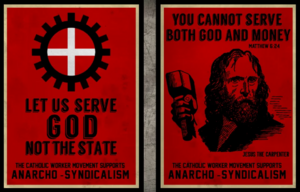
The Syndicalization
As protests and rioting started to become commonplace in most Vithinjan cities in the mid 40s, it seemed certain a civil war was looming. The three strongest militant factions at the time was the Reds, a collection of mainly militant socialists wishing to create a Democratic socialist republic, the Blacks, who was mainly a mixture of nationalist and royalist elements mainly supported by the Church to recreate the Vithinjan kingdom, and finally the Whites, a catholic-nationalistic mainly Guerig faction with some Caeric elements that mainly wished to split the nation in two and allow the Guerigs to have their own nation for the first time since before the Reformation. Of these three the Reds was by far the most powerful, holding substantial support from foreign elements while also being greatly popular among most city-dwellers in the nation. Only one of these factions would truly maintain themselves past the next year.
This civil conflict would be avoided through the most surprising of happenstances: the friendship of two very popular political figures. A lone young prince far from being the next in line for the throne together with a popular but controversial figure within the Reds would utilize each other as informants to undermine many of the main leaders within both the Red and Black movements. Through this process they were able to reshape both. The Reds would be focused more on a strange new Syndicalist idea and have their hostility turned mostly away from the Royals instead focusing it on the rich capitalistist of the nation. Meanwhile the more aggressive nationalist element within the royalist would be compared to the Whites they fought, branded as a group that would ensure the splintering of the nation. Most importantly of all, the young prince would challange the heir for the right of succession, and win. To this day it is a quite controversial subject as many historians, especially foreign once, believe the young prince to have cheated somehow. In the end though, their schemes would pay off, as they got control of the Red and Black factions allowing them to reach their ultimate goal: Peace. The two would meet officially together with most other important figures of both sides and attempt to figure out a way for each to work with the other. It took over a week of arguing just to get the group to agree that this would even be possible, but over the next months they would work out an agreement that everyone could accept. This was being done at the same time as their followers rose up and took over the government and the White faction was defeated by the much more numerous and powerful alliance. The deal that was finally made would become the new Vithinjan constitution and always be known under a single name: The Vithinjan Compromise.

After the end of the revolution the new government set the nation to focus on reconstruction and the implementation of a new, decentralized planned economy. This would also lead to a new age of isolationism for Vithinja, where almost no trade international trade was allowed, with some small exceptions mainly for Burgundine and Coscovian dealings that were seen as being traditional agreements between cultures rather than corporate markets. The main exception however was Caergwynn, with whom larger trade deals were established. All of these dealings turned out to be excessively profitable for Caergwynn, as they were able to serve as the middleman for many Vithinjan goods to reach the global market. During this period of isolation Vithinja focused a lot of it's efforts on it's own scientific sector, hoping to overcome their meager size through technological supremacy for whenever the next war would come.
Although the idea of forming the nation around the Compromise was to ensure the end of internal conflict, after the sudden death of the two creators of the new national order disagreements would soon lead to a strong rivalry to be born between the Blacks and the Reds. This conflict would quickly be played out in certain reforms to the government, which started to chip away at the Royal Ensurances that the compromise had allowed. In an important year for power over these possible changes the royalist were utterly beaten, and it was only through some difficult political manuevering that they prevented a total loss of the Royal Ensurances, having to give up quite a few of them. After achieving this political dominance the reds also doubled down on the isolationism of the nation, reducing exports to Caergwynn especially in areas where they mostly just resold the goods while also antagonizing many other foreign powers over Vithinjan territorial waters. This antagonizm and general hostility towards foreign nations would especially sour relations between the Reds and Caergwynn.
During the 70s the Reds would run into a number of scandals that would slowly tilt public confidence away from the faction. The most substantial of these was a large-scale corruption scandal surrounding the construction sector, which reached it's peak when it was proven that two of the latest nuclear reactors the nation had built were severely lacking in their safety features, which could've lead to an international crisis if these issues had not been discovered and adressed. As a result of these scandals there was a splintering of the Red faction, with multiple new factions drifting towards a more cooperative view of their Black opposition. All of this would build towards the elective season of 1984, where it was expected that the Reds would finally lose their grip of power around the National Council. Unfortunately for the Reds, this would only be the second worst nuclear-related scandal they would be involved in.
In 1983 a nuclear blast was detected in the arctic in a region currently claimed by Vithinja. This blast would serve as undeniable proof that Vithinja had an active nuclear-arms program. With it's hostile demeaner and lack of international allies, this would result in international sanctions and an indirect embargo, with Caergwynn being pressured to seize it's trade agreements with Vithinja. With all of these issues coming up just as the nation was preparing to elect a new National Council, the Reds did something unprecidented since the revolution of 1807: They marched on parliament to seize the power directly. This would result in the Battle of Tingssundabron, where the princess-Valkyrian would fight together with her royal guard to protect the parliament against the Reds attempted coup. What would follow would be a swift but effective counter-coup by the largest branch from the Reds: the Cooperatist. They would seize the suspected schemers behind the plot to overthrow the government and ensure that the next elective season was carried out post-haste. The end result was a collapse of support for the Reds, with the Cooperatist and the Royalists becoming the two largest factions in the Assembly.
New Cooperatist Order
The Cooperatist would take Vithinja and a whole new direction, quickly opening the country up to foreign trade, even if corporative representation and interests were still discouraged. They would also start to open new diplomatic channels especially with nations like Burgundie and Kiravia to help the nation find new treaties and possible allies.
One of the effects of this new economic policy was the Vithinjan Economic Miracle, where the Vithinjan economy suddenly grew by several sizes in only a few years. This boom exteneds almost all the way to today, with substantial growth thanks to a new export-based economy built most of all on natural resources and heavy machine industries. This would also see the birth of one of the stranger economic sectors in Vithinja: The mercenary industry, where large paramilitary groups would sell their services to distant wars, in part to fulfill a religious zealotry granted to the most devoute of followers of the Church of Rolv.
During the Deluge Vithinja sends a substantial number of mercenaries to take part in the Conflict, some of which remain there to this day.
Although they deny it, Vithinja also sponsors some revolutionary elements in different parts of Crona.
Geography
Vithinjas varied geography is both a blessing and a curse. Although large portions of the lands are difficult to impossible to inhabit, they hold some of the most beautiful landmarks to be found in the world. Between the innumerable fjords covering the coast to the northern villages surrounded by the sights of huge tall mountain ranges, large glaciers that glimmer in the sunlight and if any visitor is lucky, the wondrous northern lights. This would make it a better tourist location if the temperature didn't drive most foreigners away.
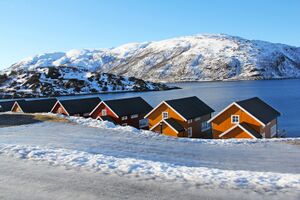
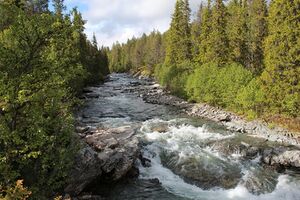

Climate
The climate in Vithinja is defined by the separation between the warmer coastal regions including the Vithinjan isles, the fjord covered northern coastlines the northern mountainous regions and the subarctic lake regions. The nations economic centers have always been tied to the coastal regions, with very little agricultural lands excluding the Vithinjan islands. A few local grains being hardy enough to survive the boreal summers thanks to the north-blowing winds. The coastlines nearest joining the two landmasses of Vithinja together however are constantly a target of the cold arctic winds from the north.

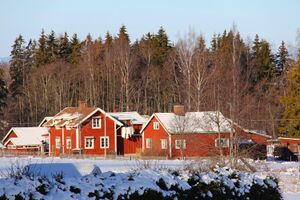
Politics
Syndicalist Government
The Vithinjan syndicalist way of governing has been classified by experts as a kind of Hierarchical Top-Down Syndicalism, with some extra complications from the Monarchical Exception and it's institutionally-enforced anti-liberal Neotribalism. This definition can be broken down as thus: Syndicalism as in the establishing of a system where people may freely form organizations that hold political influence to affect the legislative and executive powers and process of the state. Hierarchical as in these organizations being expected to form smaller joint organizations with representatives from each, who work together to help take care of matters that is in each of their interests, continuing upward as is necessary to join all organizations together at the highest point. Top-down as in these organizations were first created with a set of leading organizations above, whose powers where then divided into smaller portions for which new organizations attempted to be established, creating a starting point for the Syndicated systems powers that were then handed down a ladder of smaller organizations until it reached the local level. File:The hand that will rule the world.jpg
In effect the syndicalist government functions as a hierarchy of unions each of which may function as either an executive or legislative body, but usually both branches for part of the nations rules, laws and social groupings. The powers of each union is based on what has previously been agreed to be delegated to that level of the hierarchy from above. These powers include both serving as the executive branch for any issues the representatives bring from the legislative decisions of their own unions, one step down in the hierarchy, as well as serving as part of the legislative branch for any higher unions they send representatives to. One of the main purposes of this division of power was to ensure the each part of the government could take care of their issues swiftly and effectively. The Ällänsþinget (national council) refers to the members, who hold the title of chancellor, of the highest point in the hierarchy who hold only executive powers, including the first level of delegation of all state power towards the lower branches.
Among the unions the seven top-level unions that all other unions are subdivisions of are all based on the concept of the collar colors that was a pretty popular concept as The Syndicalization took place. At first there were only four collar-unions that represented the nation: red, black, blue and green, but today that number has risen to seven. They are as follows: the red-collar union (1951), the black-collar union (1952), the blue-collar union (1953), the green-collar union, the pink-collar union (1961), the white-collar union (1977) and the new-collar union (2001). Each of these hold one seat at the Ällänsþinget, while the Naþionelförsamligyn holds representatives based on the number of people working within each of the top unions.
Governing Parliament
The Vithinjan parliamentary body is separated between the legislative Naþionelförsamligyn (National Assembly) and the executive Ällänsþinget (National Council).
National Council
While some may worry that this would simply lead to the Ällänsþinget holding full authoritarian power, they are limited by the constitution to some degree, most importantly as they do not control the length of their terms. As each chancellor must be chosen by a union at the lowest level before they are able to start climbing the hierarchy, any chancellor who is seen as failing in their duty to the lower unions may simply be replaced, no need to even wait for an election as the Fholktinget held to determine the chancellor may be called at any time by those making the decision. This representative election is generally not referred to as an election as it is not a choice of the majority, as this is considered democratic republicanism, something that the state specifically attempts to distance itself from. Instead it is rather an agreement that is not protested by any member.
National Assembly
Despite attempting to generally distance themselves from party-like organizations as to not appear too democratic the current Vithinjan government can generally be split into certain factions. While each of the members of Naþionelförsamligyn (the National Assembly) is and individual and may choose to not follow the lead of others in the same faction, these factions give a general idea of the power balance among those leading the nation. The largest faction is the Syndical Cooperatist (Samvärckenzyndicati) [Pink seats], usually shortened to The Cooperatists. They are lead by Chancellor Magnus Tornssen, who is famous for being the creator of the Cooperatist movement and helped move Vithinja away from their previous isolationist direction after the 1983 Noborean Nuclear Test. Since 2019 he has been the single longest leading chancellor, leading the reds since 2007 continuously while also leading them between 1991 and 1999. He is nearing 40 years since he first achieved a position in the national council at the young age of 28. Among his achievements he has successfully pushed Vithinja from mostly domestic economy to a vibrant export based economy, while also helping improve relations with foreign partners nearly universally. His critics points out that he has continuously promised to cut down Vithinjan military spending for over 25 years with little success, although more significantly he is often a target of both internal and external environmentalists who point out how he is the main reason for Vithinjan environmental policy being by modern standards especially abysmal considering it is a mainly train-based economy. The Cooperatists as a whole hold 67 seats in the national assembly, mainly from the reds and the blues, but has supporters from every collar-union except the blacks. Currently the Cooperatists are alone in controlling more than one of the Chancellor seats, as both blue-chancellor Rikart Ragnersson and new-chancellor Lina Birgittdotr are important figures in the faction. Thanks to this near majority in the national council they maintain great executive powers as long as they can convince a single other faction to work with them on whatever issue may be in question. This is helped by most other factions having greater disagreements with each other than they do with the Cooperatists.
The largest faction is the Syndical Cooperatist (Samvärckenzyndicati) [Pink seats], usually shortened to The Cooperatists. They are lead by Chancellor Magnus Tornssen, who is famous for being the creator of the Cooperatist movement and helped move Vithinja away from their previous isolationist direction after the 1983 Noborean Nuclear Test. Since 2019 he has been the single longest leading chancellor, leading the reds since 2007 continuously while also leading them between 1991 and 1999. He is nearing 40 years since he first achieved a position in the national council at the young age of 28. Among his achievements he has successfully pushed Vithinja from mostly domestic economy to a vibrant export based economy, while also helping improve relations with foreign partners nearly universally. His critics points out that he has continuously promised to cut down Vithinjan military spending for over 25 years with little success, although more significantly he is often a target of both internal and external environmentalists who point out how he is the main reason for Vithinjan environmental policy being by modern standards especially abysmal considering it is a mainly train-based economy. The Cooperatists as a whole hold 67 seats in the national assembly, mainly from the reds and the blues, but has supporters from every collar-union except the blacks. Currently the Cooperatists are alone in controlling more than one of the Chancellor seats, as both blue-chancellor Rikart Ragnersson and new-chancellor Lina Birgittdotr are important figures in the faction. Thanks to this near majority in the national council they maintain great executive powers as long as they can convince a single other faction to work with them on whatever issue may be in question. This is helped by most other factions having greater disagreements with each other than they do with the Cooperatists.
Representing the older original Syndicalist ways, the Boreal Syndicalists (Noboreazyndicati) [Red seats] often just called Syndicalists as many believe they represent the ideals of the ideology. Out of all the factions in the National Assembly they are the most critical of the monarchy in addition to finding entanglement with the global market to be damaging to the rights of the people. They maintain a good 48 seats, although this often holds little power as the only other faction that commonly works with them on policies is the Environmentalists. Today they are lead by green-chancellor Sten Vikqvist, who has been trying to modernize and strengthen the faction in a number of ways. These include shifting their stance from full economic isolationism towards a more moderate total ban on foreign investments or the new stance of tolerance of the Church rather than opposition. In the end their most important shift has been towards more green efforts, creating an ally in the Environmentalists.
The Traditional Monarchists (Fholkungaföljerne) [Dark-blue seats], or Conservatives, is a conservative faction mainly built around the ideals and values of the Church of Rolv. Ever since the Cooperatist counter-coup of 1984 they have been a close ally to the Cooperatists. Although they were once one of the two dominant factions together with the Syndicalists they now only hold 43 seats. By tradition the black-chancellor have always been lead by the King, who thus always becomes the leader of the conservatives as well, leaving Rolv XI Sortvit as their leader today. He has been working hard to maintain his alliance with the Cooperatists and working to ensure their policies would align more often. The conservatives as a whole have mainly focused on preventing the erosion of more traditional values and ideals, very rarely implementing more reactionary changes instead focusing on denying certain kinds of change.
Among the more reason additions to the assembly, the National Syndicalists (Naþionelzyndicati) [Brown seats], often referred to as Natsynds, split off from the Syndicalist factions in the early 2000's. They mostly hold views that can be roughly placed somewhere in between the Syndicalists, Cooperatists and Conservatives. One of their most defining features is that they believe that Vithinja is a gothic nation first, with it's more celtic inclinations only to be tolerated, not accepted. Despite their short existence they already hold 42 seat, almost surpassing the old Conservatives. They are currently lead by white-chancellor Riordan Mayor, although his hold of the faction is weak. His attempts to similarly make the group more appealing to a modern audience similar to the Syndicalists has lead to many in the faction considering him soft. Many suspect that one of the more radical representatives within the assembly will soon replace him, which will likely cause him to lose his place as chancellor.
Despite being one of the oldest factions in the assembly the Syndical Environmentalists (Zyndicatister fyr Meljöen) [Green seats] have struggled to gain support for most of their existence. Their ideas for bettering the future are hold strong support in many other nations but this is not to their advantage, as there is a common rumor that they were born from and still gain from foreign supports and especially scandalous: foreign investments. Even with all of this against them they hold 21 seats, which is still the height of their popularity. Being lead by pink-chancellor Ingrid Fridsdotr, they have taken on the ideals of the modern progressive movement. Fridsdotr was the first councilor and first chancellor to call herself a feminist, which has made her popular especially among many in the more progressive youth, but has also made her many enemies within the assembly who view her ideas as unpatriotic.
Finally, the Liberal Monarchists (Frijehits Partiet) [Light-blue seats] who only joined the assembly five years ago hold a decent 8 seats. Many believe that they movement had no chance to ever enter into the assembly, which was true for more than 50 years. But with the efforts of their leader, white-representative Aron Watch as well as suspected support from the somewhat popular Prince Valker Sortvit. They currently push ideas that seem to be mainly inspired by a combination of Burgundine and Caeric views on liberalism. Meanwhile, chancellor Watch is most famous for being the first representative to get into a brawl with his own chancellor, Riordan Mayor, over an attempt to pressure white-representatives into supporting the national syndicalists. He attempts to gain support both among his own but also from the Environmentalists, in part by pushing a progressive set of ideas but that are more in line with the common culture within Vithinja.
Top-Level Union
Among the top-level unions the red- and black-collars are considered special. The reds generally represent those who should directly support the syndicalists who created the current nation. Because of this there are many additional rules to high level members of these unions. Similarly the blacks represent the powers and interests of the Church of Rolv and through them in part the royal family. As such they have multiple high-level positions in the union be designated by the Church and even one or two designated by the king. It is not law but tradition that no member of the royal family should take the position as union representatives, outside of the chancellor position held by the king. Similarly it is also traditions and acceptance by their members that allow the Church and king to designate positions rather than leaving it to a more direct elective process.
Judiciary
The strangest and probably most important two unions below the high seven is the Union of the Lower Courts and the Higher Justice Union. These both represent the courts, one representing the higher courts and the other the lower courts. Despite their obvious connection they belong to different higher unions. The lower courts belong to the red-collars and the higher courts belong to the black-collars. This is because of one of the compromises in the constitution, where the syndicalists received control of the sub-regional courts while the king remained in control of regional and national courts.
Constitution
The Vithinjan constitution, a product of the Vithinjan Compromise, is an unorthodox work as it is a product of three origins. The constitution borrows a few things from the constitution of the old Boreal Republic, however this is the smallest component in the text. Secondly and thirdly it is sourced from the compromise between the government of the royal Sortvit family and their supporters as well as the Syndicalists that made up the nations labor unions during the Second Great War. This has caused large parts of the constitution to have proved over the years to be a convoluted mess that contradicts itself in more than a few places. Because of the constitutions contradictory nature most of the time the national council and the king both simply use the powers that previous rulers have used, avoiding actions that may cause a constitutional crisis. This is not true for a few of the core principles of the Compromise, such as the Syndicalists promising that the Church and the Syndicalists would not use violence against each other to enforce their beliefs, something that has lead to every single breach of this principle causing a severe loss of support for the violating party. It also states that the state must be organized top-down, defining the collar-based system to use as the stability of the Syndical system is believed to be weak if no stable structure is enforced at the top. Even with this principle the top level of the government has been shown to be far more dynamic than most parliamentary systems.
Anti-liberal Neotribalism
The constitution is very clear on one issue: the Syndicalist kingdom would NOT hold elections and is NOT a democratic nor republican body. The people would hold power and representation in the government through their union and choose their leaders and representatives, but this choice is not required to be elective in nature. Communities are left to define their own folkmoots rules for these selections and they should NOT be referred to as elections, even if they end up functioning the same.
Despite this decree it is today quite common for Vithinjans to refer to their selection process as an election and being elective, in part because more than half of all unions make their choices in very democratic-like ways.
Citizenship and Residents
Because of the Syndical institutions putting themselves in opposition to common democratic institutions the idea of citizenship doesn't quite exist in Vithinja. However there is still a way for any resident in the country to affect the political makeup of the nations leadership. This comes in only through a single way: union membership. The difficulty of joining a union varies greatly by profession and region. All of this effectively means that if only members of a union are considered citizens (which most agree is a fact) only about 82% of all Vithinjans above the age of 16 (And ~30% of 14-16 year olds) are citizens, leaving 18% to simply be residents.
When the citizenship system was implemented with the Compromise, there was only one union which anyone can always join: the military. To be an official member of the military a Vithinjan needs to be a full time serviceman. Reservists who want the power to elect need to join the separate reservist union, which while also an option it is not usually enough to subside on alone.
Because of the mostly professional requirements for effective citizenship Vithinja is often considered to be a great place to immigrate to for people who have the right skills. It can take as little as a month to go from seeking a temporary residency visa to becoming a union member and thus a voting citizen.
As there are quite a few who believe that either joining a union is too difficult or simply that there should be a union for those who could be classified as residents, there is a modern civil rights movement in the nation that in part advocates for these changes, especially as the vast majority of residents are celts many of whom feel that discrimination is a factor in their lack of representation.
Administrative Divisions
Military
The Vithinjan military can be divided into three distinct organizations: The Kingdoms Flotilla of Vithinja (Viþinjske Rikysflottjan), The Union of the National Reserve (Fhecket fyr Länsvärnent) and the Guards of the Revolution (Nydåningsvacktyt). Some would only consider the first two as actual members of the military and the third as a paramilitary organization, especially since the constitution contradicts itself when describing them. The Kingdoms Flotilla is divided into four main components: The Royal Marines (Rikysvärnet), The Valkyries (Valkyrierne), the Homeland Navy (Länsförsvarsflottan) and the Wolves (Ulvärne).

Economy
The economy of Vithinja has in modern times been pushed to switch from an export-oriented market economy during the Boreal Republc, to a totally mobilized arms economy for the duration of the Second Great War, to a partially isolationist decentralized planned economy until the Counter Coup of 1984, to the modern mixed-export-oriented economy with some elements of the previous planned economy remaining. This apparent instability would likely have lead to the nation having further issues if it wasn't for three helpful factors: extensive resource wealth, a continues and successfully maintained legal institution dating back over 200 years and finally a strong working culture where the populations identities, social communities, political movements as well as very often large parts of their families are all organized around their professions. It is these factors that are often pointed towards when investigating the Vithinjan 1990 economic miracle, where the nominal per capita GDP of the nation jumped over $15 000 in a decade, while still growing at a good rate to this day.
Today the Vithinjan economy is commonly divided into the three primary sectors: Energy, Mining and Transportation. These are often joined by the three secondary sectors: Timber, Medicine and Defense.
Primary
Energy
For domestic production Vithinjan electricity is largely comes from hydroelectric dams and nuclear power plants. As these have for a very long time produced a surplus Vithinja always looks to export whatever energy it can. Their main energy trading partner is Caergwynn, who has a well functioning grid connection with Vithinja, allowing easy access to Vithinjan power production.
When it comes to transportation, Vithinja is a heavily train based economy, with nearly ten times the train travelers compared to cars and more than fifty times as much of goods transportation using trains over trucks. Most of this rail network is electrified, with the exception of the most remote and unpopulated regions.
These facts should by easily make Vithinja one of the most green nations in the world. But this is not the case. They are above average thanks to these factors but two simple parts of the nations energy concerns cover more than 80% of pollution. These are the large mining sector as well as heating. Vithinja needs a lot of fuel to run the machinery in the mining sector, causing pollution in the more resource wealthy regions. But the heating issue is by far the worst part for any environmental efforts. With the average citizen having to deal with on average three months of -15 degrees Celsius, Vithinja is one of the most energy hungry nations in the world every winter. For this heating more than 90% of households and workplaces utilize natural gas for this heating.
With this in mind, Vithinja is one of very few nations in the world who still in the 2020's have not only not accepted any attempts to push them towards greener efforts, but their leading party actively advocates against it, as a threat to national interests. The other side of the Energy sector is the extractions of carbohydrates. Vithinja features some of the largest proven natural gas reserves in the world, as well as a few good petroleum sources. These are heavily exploited, for a nation of it's size, but with more hands and investments there is still substantial room for expansion. These natural gas reserves are an important part of North Levantine energy economics.
Transportation
Vithinja has one of the most heavily train based economies in the world. This is based in their previous isolationist period, where they avoided implementation of roadways as it was protested against by the average worker, mainly either for economic considerations or because they feared cars would ruin the layout of their cities. Because of this isolationism the transportation sector had to be entirely domestic. Today it this has resulted in a large export sector surrounding trains, maritime vessels and smaller airplanes. This includes not only the production of machinery and other components for these vehicles but also research and economic theory developing new and improved methods for these industries.
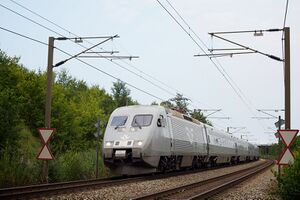
Mining
While Vithinja has large manufacturing and service sectors, but since the time of their economic isolation the nation has built their industries mainly on resources extracted at home. These includes large mineral wealth, mainly iron, copper and tungsten. Even though there are other reserves for metals important in the industry these three are impactful as they make up the vast majority of domestically produced materials for the large manufacturing sector. The main missing material for this is aluminum, which now makes up one of the most important imports in the entire economy. Vithinja has spent an obscene amount surveying for the light metal, but with little success.
Secondary
Timber
As the vast majority of Vithinjan lands are unsettled the country features extensive forests mainly of a large variety of conifers. Most vitally is the common spruces and pines of the coastal valleys of Borea, which provide among the most valuable kind of basic timber in the world, thanks to some variety of environmental factors providing for great growth. This has lead to Vithinja being an importanr exporter of wooden products such as furniture in theast 40 years, turning out to fill a hole in the market no one knew was there.
Pharmaceuticals
Thanks to large-scale investments in researh within medicine during the isolation years Vithinja now has a pretty sizable industry built around the production and exports of certain pharmaceuticals, being the main producer for multiple common antidepressants, pain killers and centrlstimulants.
Defense
Despite Most of the Vithinjan military production once being completely export banned, since the 70s they have been exporting mostly older modules of various infantry equipment. Most of these exports are to many of the central cronan nations such as Kelekona and Malentina.
Infrastructure
While large parts of the world started moving over towards building roads for cars, the Syndicalists of Vithinja stubbornly leaned away from car travel and towards trains. Because of this Vithinja is one of the worst places in the world to bring a car, but has some of the best railway connectivity of any nation.
Taxes
Taxes in Vithinja are collected from the unions by the unions with the exception of the military tax, which is collected from everyone. Because of a convoluted taxing system when it comes to income tax Vithinjans pay a very sizeable tax rate which looks way less to the majority who is uninformed of the details of the taxing system. Vithinja has a pretty standard tax rate on inheritance and a huge tax rate on land ownership that is not owned by a union.
Military Industrial Complex
old
Because of the remnants of a strong warrior culture Vithinja has always had a loose view of weapon ownership. Since the Syndicalization this idea of privately owning a firearm has continued to be encouraged, with the exception of those who could be seen as residents, for whom owning a firearm is illegal. Vithinja has one of the highest rates of firearm ownership, with over 125 firearms for every 100 people.
Demographics
Population
The Vithinjan population is officially broken up into five accepted native demographics, with a secondary break up based on languages. These five demographics are: the Ruthans, who make up just under 22% of the population; the Guerigoles, who make up almost 35% of the population; the Ruth-Gvärs, who make up about 19% of the population; the Novalke who make up just over 14% of the population; and finally the Caerics, who make up 5% of the population. The numbers for these demographics are exact as it is a component of every persons recorded information at birth for the governments identification data.
Language
The official and most spoken language in Vithinja is Ruthi, a gothic language very unlike most other gothic languages, with strong influences from the celtic, coscovian and burgundi languages. This is the expected language to use for any official work such as law, education and research. Almost as common but not always allowed officially is Siarvish, a celtic language closely related to Caeric. While in some regions one can easily live only ever speaking Siarvish it is difficult to achieve great success without also learning Ruthi. Both of these languages may be taught at schools but most schools either teach Ruthi or both. There is also a few minority languages, especially within the Novalke group, some of which are allowed regionally but most are rarely even taught in local schools. On the Vithinjan isles, especially in the south there are many who still speak Caeric. While recognized as a regional language it is often discouraged, usually by the higher levels of unions, to use the language outside of private matters. Considering private business is strongly discouraged this essentially means using it at home if at all.
Religion
Vithinja is a religiously divided nation. In the Novalke and Ruthi Language regions the Church of Rolv, a unique protestant branch which implements many ideas from the old pagan beliefs of the region, still holds a lot of power and support. This church is the main reason for the survival of the monarchy, as the royals serve as important figures within the faith. Then among mainly the Guerigs especially in the northeast there is still a strong catholic presence. It is weaker than the other two but serves as one of the main points of internal conflict within the nation. Finally there is the idea of fully abandoning the old beliefs which is an idea that was heavily pushed by the Syndicalist movement and holds strongest in the southern parts of the nation. At one point the Syndicalists tried to push for a fully secular nation, but failed in the face of the Church of Rolv almost breaking the nation apart.
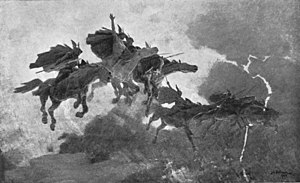
Religion in Vithinja according to official survey (2027)
Education
Education in Vithinja is completely controlled by the government, as private schools have been made illegal by the union of education. While the government attempts to specifically encourage certain education paths, these efforts have generally lead to educating way more members than needed into a narrow field. Recently new efforts have been made to address these issues.
Health
Vithinja features a very extensive public healthcare system. The union of healthcare holds a lot of influence and has at numerous occasions pressured other industries towards decisions that would assist public health. One of these choices is a complete ban on smoking and huge efforts toward reducing drinking. Despite these efforts both smoking and drinking are still publicly practiced in many communities. Tobacco smuggling is an extremely profitable black market in Vithinja because of these efforts.
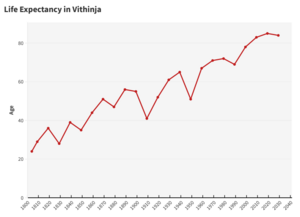
Crime
For being a nation in modern times Vithinja features a large indirect punishment for pretty much any crime: increased difficulty to join a union, which makes everything from getting a job to finding a partner more difficult and may lock one out of the political process. Despite this the number of people convicted for a crime has been hovering around 2.5% up until the last two years, where it has slowly increased to 3%. It is often noted that 90% of convictions are against those already considered residents, and 95% of everyone who has a criminal record are residents.
Culture
The peoples in Vithinja are largely a strongly traditional people, just with very different traditions than most Christian nations. The core of Vithinjan culture is a great respect for communal power, the expectation for people to voice their concerns and fight against anyone trying to force them to change, and a strong family unit.
Communal power in Vithinja is available through any Union employee. This power does not just refer to the individual (or in some areas, families) ability to influence decisions made by their own community, but also the communities ability to influence the decisions made above them. Many of the traditional ideals surrounding communal power, such as the folkmoot, have later served as the inspiration for the creation of the new Syndicalist order. Under the Syndicalist system this power is always in effect through the enormous structure that is the Union Hierarchy, where each employee makes decisions surrounding their operations in cooperation with other similar unions together forming union alliances to gain enough popular support to pressure officials further up the hierarchy. An important component to this communal power whether it be in the unions or the folkmoots is the individuals ability to stand up for what they believe even when faced against a majority. Every person is expected to give their view, and only change it once they are convinced. Such thinking are the origins of Vithinjan elective systems dating as far back as the 10th century, and would become a significant factor in the ruling structure of the Vithinjan nation after the 15th century. Even though these ideas are honestly quite near to and similar to common republican ideas of democracy, Vithinja specifically distances itself from both. An idea of the Tainted Democratic Republicanism has held strong in Vithinja since the failures of the Borean Republic as well as the First Vithinjan Republic. The total failures of these systems served as evidence in Vithinja that the liberal experiment was a failure that only weakened the nation enough that other powers could consume them. Despite this large taboo liberal ideas have been slowly creeping back into Vithinjan politics in the last twenty years.
The fighting spirit which lives strongly in the nations cultures is one of the more influential forces in the Vithinjan society. It is a common belief that once inner violence should not be suppressed, nor should it be let run wild. One should shepherd once violent soul so that when it is needed it can overpower anything that would threaten your kin. This does not play out that well a lot of the time, and violence of many kinds is rampant in many parts of Vithinja. The state has built a lot of institutions to resolve this issue, not to reduce the violent ideals as they are seen as vital in the nations continuous survival, but through outlets. Sports in Vithinja are the most common outlet, with most sports including more protective gear than in other countries specifically to allow people to take more of a pounding during their games. Another outlet in the modern day is video games, as they often serve as a quick and easy way to give someone a way to vent. Finally... for those who have passed the point of no return, Vithinja features a sizable paramilitary. For those with at least some control they will often find themselves in the Revolutionary Guard, ready to protect the freedoms of the workers if ever necessary. For everyone else, there is the 'Fecket fyr Legosoldatir' (The Mercenary Union). A collection of organizations that are Private Military Companies in all but name (because of language taboo). These operate in conflicts all around the world for whatever their goal may be; whether that be money, glory or political change.
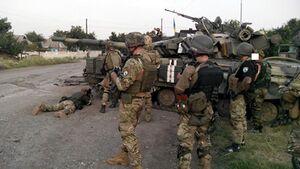
Being close with your family in Vithinja is meant far more literally than in most other Christian nations. Different kinds of physical contact such as sitting in someone's lap or lying in a sofa together is common within most households. One of the traditions which foreigners find most strange, and even most southern Vithinjans are starting to distance themselves from, is the single massive bed most old school households use. Having the whole family share a bed is a tradition which dates back to ancient times where it was simply a tool for keeping warm. This is only one of many such examples, another is that it is common for the youngest son to sit in the lap of their mother and the youngest daughter to sit in the lap of their father during dinner. While some foreigners view these things as obscene, ironically enough when Vithinjan families are seen breaking these norms in more conservative parts it is often viewed as a sign of lacking trust and devotion towards your family.
The Church of Rolv
The Church of Rolv is the largest religion in Vithinja. While it is often classified as a Lutheran protestant branch together with most others, there are many who disagree with this classification as it has little in common with any other popular branch, with the exception of some similarities to the Caeric branch. The official definition for the branch the Church of Rolv belongs to is Conjungites, a group which heavily emphasizes the integration of local traditions into a Christian framing.
While the foundation the branch is built on has it's roots in the same reformation as most other early protestant branches it differs in it's originator and purpose. Such difference also greatly expanded over time, as the directions of the branches are incomparable. The Church of Rolv is a unifying faith based in the idea that the old Paganism of the Vithinjan natives is not truly incompatible with the Christian faith. Instead the old pagan ideas are simply a failure to communicate some of the many ideas behind Christiandom, therefore allowing them to fill a similar if lesser purpose than that of the old testament, with interpretations of the intents and meanings of these old legends needing theological examination. As Gods full teachings have been in part corrupted or forgotten in these regions, the old pagan beliefs can be used to help guide and understand what parts of the old testament is most important and what the true expectations upon the rulers, representatives and followers of the divine are.
One of the most important differences as thus is the distinctions, comparisons, separations and representations of rulers chosen by god and angels serving as his messengers mean. One of the distinctive beliefs is that the Christian idea of angels generally being male is incorrect, that there is a separation between the two kinds of representatives for god. Those who spread gods name to foreign lands serve as the traveling messengers on missions in gods name. As those angels are male, so is the priests who now represent them. Meanwhile, for those who stay in the various communities, maintaining gods connection to his followers, those angels and their representatives must be women.
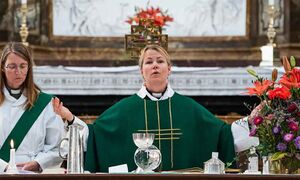
Within the ruling family there was two things made very clear: The rulers are representatives of god, just like the kings of old, no divine representative is needed to grant this right of rule if ones family has been blessed for this purpose. Thus the royal family of Vithinja (and some other Royal bloodlines) are seen as holding the right of rule within their blood, with the blood of other dynasties being a somewhat disputed topic. This means the whole family, there is no room to waste the royal blood of children just because they are women, all must help serve their divinely given purpose. The ideas and roles of the royal rulers family is in part parted by sex but mainly by what must be maintained.
The Kings task is to rule over all, not in every detail but as a single whole. He must not be specialized, and any faults he has must be accounted for, for his power is not in taking care of tasks himself, but in applying the right part of the people and the nation to the purpose. But only the royals may rule. Thus he must ensure his family can make up for all his needed skills and faults. As such the remaining siblings and children must all be made to serve the role of ensuring all the tasks of the king have a skilled expert ready to serve as the kings acting hands. While the exact nature of what these expert roles are has varied greatly over time, a few specific roles have been maintained almost since the faiths establishing. The first of these is the kings heir. The heir is the oldest son who has not been defeated at a fair trial of the heirs choosing. As the king rules all, one can not be king if they cannot ensure their own win when choosing their field of battle. Second is the Valkyran and Valkyrian. The Valkyran is the royal most capable of leading offensive warfare. He ensure that the capabilities necessary to defeat an enemy completely is always available to the king. The Valkyrian represent the defensive understanding that any army attempting to march on their capital will find itself against an impenetrable wall while withering away from skirmishers devastating their supply lines. She ensures that the king may feel safe sending most of his armies to invade their foes, as outnumbered thirty-to-one his Valkyrian will still ensure there will be no victory for any invaders. File:Freya by C. E. Doepler.jpg
All royals hold the expectation that they act according to their divine duty, with no exceptions. Thus beside extraordinary circumstances such as being deeply wounded or in the late stages of maternity, all Royal Family members are expected to take part in and carry out the rulership of their people.
Arts
Literature
Vithinja features a lot of literature especially within the areas of fiction, having many more fictional stories written in the age between the reformation and the modern era than almost any other nation. A common tradition in these stories are a close link with reality, either taking place in a fictional setting in our world or a very real setting with a small fictional twist. Stories of this kind have their origin in old mythological texts from both North Gothic and Gogaul writings. such as "The Saga of Leo and Luke", "Yormounzander, Sagas of the Vanquished" and "Warulf and the Blue Moon". More modern usually implement implement Christian ideas, often in ways which many Catholics would find obscene. Some of the most famous examples in todays pop culture include the book series "Hellsview" and "Daughters of the Valkyrian", as well as the video game Struggle of Sagas.
It has also been common among the nations intelligencia to write philosophy, poetry and political theory, leading to creations such as "The Unification", "Compartments of Liberty", "Gvärs y Gevär" "Atd Valhallar" and "Our Right to Heaven".
Most of this writing is from the time before the Syndicalization, with the new form of government most kinds of artistic literature were discouraged, with the exception of political theory and philosophy. Since the Cooperatist Coup however literature has been on the way back into the mainstream. Literature is still however mostly seen as being for academics or just old-school in general, with most Vithinjans more focused on other artistic areas.
One of the exception is in the creation of more erotic creations, as comparatively Vithinja has been more accepting of their printing than many other nations. Even the Syndicalization failed to deter this particularly profitable sector, today being one of the largest exporters of this kind of content in the world. A large reason for the success of this industry is the extreme profitability of smuggling such content as part of the Vice Trade.
Music
Traditional folksongs and myths from the North-Gothic and North-Celtic are still an important part of modern culture in Vithinja. Most musical productions today is in one way or another sourced from one of these two traditions. Alternatively some would even make a more modern mixture of both the two cultures, a somewhat controversial direction mostly taken by the nations youths. This originally lead to a strange dynamic of slower, older, tune flowing between quiet melodies to loud choruses. Until modern times this allowed for mostly traditional or archaic instruments for musical creations. Most Vithinjan music has a large emphasize on utilizing the language to ensure as perfect of a harmony as is feasible.
A notable feature of most Vithinjan classical or folksong orchestras is that they nearly always features both a men's chorus and a woman's choir. The two of them are usually used to create a duality in most Vithinjan classical music, often serving as opposing forces in the songs narrative. Another fascinating tradition is the "Mountainsong". To create Mountainsong musicians must climb high into the vast mountain ranges of Vithinja, usually in areas with little to no residents because of avalanches. The performance utilizes the echoes of the mountains to give it's music a magical feeling that is hard to replicate with modern technology, and was impossible to replicate for most of history. These performances also utilize the Vithinjan Alphorn, a 5-12ft long horn originally used for long-distance communication in the mountains. Horns of various kinds is the most common and popular kind of instrument in these groups.
Opposite to the slower traditional music is a very fast, excessively loud often electronic music trend created by a "rebelling" youth since the 80's which is only getting stronger in the modern age. These creators are often small groups of younger Vithinjans playing in simple local locals (not garages though since 90% of Vithinjans don't own cars). This new wave of music is mostly made up of various kinds of intense, highly rhythmic electronic music as well as a number of popular heavy metal bands. Later in the 2000's a pair of homemade strains of Hip-Hop music would also start to develop one developing out of nationalistic Guerig communities and the other from the up and coming Tech sector.
Most of Vithinja is relatively reclusive with their musical tastes, not really entertaining the creation of music in foreign languages, with the exception of Caeric and some Coscovian songs, which are considered very respectable languages in large parts of the nation. This is in part because both of the main global languages, Anglish and Latin are considered to be very unharmonic (especially Anglish, which is the preferred international language in Vithinja) which generally makes most foreign music sound "wrong".
Media
News
While there are many smaller and/or more local options, there are three main news organization, mainly referred to by the name of their newspapers: Fholks Däglige, Vikpappret and Händskaren.
Fholks Däglige is a Socialist leaning publication that serves as the main producer of news publications targeted at mainly the Syndicalist audience.
Vikpappret on the other hand has a long historical connection to the Church and Crown, serving to represent their interests.
Händskaren only really started to appear after the Cooperatist counter-coup of 1984 and features a larger range of opinions, including the more centrist Cooperatist viewpoint. It is also well known that a large sponsor of this publisher is the 4th prince Valkeer Sortvit, who is one of the main representatives of the Liberal Monarchist movement.
Cinema
Before the Syndicalization cinema was mostly seen as a tool for foreign influence and was therefore discouraged. This didn't stop a select few cinemas opening in the years before the Second Great War in some of the largest cities. In this timeframe a handful of Vithinjan made films were made, but none gained much interest.
During the early years of The Syndicalization the new regime pushed heavily to create a decent local industry for cinema, as it's use for influencing the population had been proven by others during GW2. Up until the Cooperatist took power the cinema in Vithinja became one of the main battleground between the Monarchists and Syndicalists, trying to influence the population to give either one enough power to rid themselves of the Compromise. Although some foreign films still made it to cinema, especially among the most popular fictional creations, for the most part the government nearly monopolized the film reels across the nation. This heated up particularly when the TV became accessibly to the common family in most of the country.
After the The Cooperatist counter coup the government grip around cinema was finally released and the former propaganda creators would develop into a homegrown movie industry. They would have much tougher opposition from all of the movies surging in from the rest of the world now that the market was opening up.
Sports
Hockey
Vithinja is the inventor of both ice hockey and field hockey. They are an important part of the nations history.
While many other nations take the most interest in football the household sport in Vithinja has been hockey ever since the commercialization of the radio. This applies to in part to field hockey, which is more common to be played by youths and in private as well as being generally more popular in souther regions. Ice hockey is however much more popular professionally and gets far more media attention. Vithinjan hockey referees are often less strict with more violent acts than what is common in international settings, leading to Vithinja having by far the most penalty time assigned to them in world-cup games, to the point that they almost double the runner up nation. This has however not prevented Vithinja from becoming one of the most successful nations in international hockey, with their penalty times perhaps being the only thing preventing them from total dominance within the sport.

Skiing
Skiing is also a very popular sport in Vithinja. Although competitively most people are interested in downhill skiing and ski jumping, among the common public cross-country skiing is generally more popular. Another popular competitive skiing option is the imported 'biathlon', where cross-country is combined with rifle shooting.

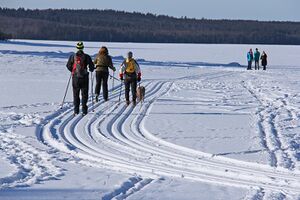
Football
Can either refer to Football or Soccer in Vithinja. Both are called 'Fotboll'.
Rugby Football is somewhat popular in the South especially among students. Interest is growing. It lacks enough interest in watching national events to be more than a regional sport.
Soccer is quite rare in Vithinja. The kind of environment that is best suited for it is somewhat limited, and most Vithinjans think the rules are in the way to let anything fun (violent) happen.
Fencing
Fencing in Vithinja has been common among the royal family since it's inception. This tradition was picked up by many after the Vithinjan Compromise.
This fencing is most commonly done with two handed swords, requiring much more protective gear than fencing with rapiers or other smaller weapons.
Nascar
Despite the Vithinjan markets lack of cars, this deadly motorsport has found it's way into the hearts of enough of the populous to be one of the most popular sports in the nation.
Hunting
Hunting for sport used to be a common practice especially among the wealthiest in Vithinja. This practice was largely wiped out by the Syndicalisation but remains within the Royal Family. Today there are heavy restrictions on hunting, which mostly apply to the royals as well. Despite this it is common tradition today for the Vithinjan ruler to release a film of themselves hunting down a polar bear once per year.
Tourism
Skiing
Skiing vacations is the most common reasons for tourists to travel to Vithinja. The number of options for mountain resorts is extensive and what the nation doesn't have in the largest and most luxurious of resort it makes up for in sheer bulk of options. You want to head to a resort where you are almost alone in the area? You can do that at almost any time of the year. Because of the union overseeing the skiing resort focusing on number of tourists rather than pressing out the most possible money from each, Vithinja is able to present itself as an option to those with less money to spend.
Vithinja also used to hold a near-monopoly on cross-country skiing resorts until the trend was picked up more internationally in the 2010s.
Veterans
Vithinjan tourist centers are often especially targeted at soldiers from other nations. This is in large part because a lot of Vithinjan tourist locations serve as a place for people to take out their competitive spirit, aggressions and test themselves in a real fight. Barfights, hooliganism and street brawls are not a rare sight in some of the more extreme tourist locations. These fights usually include both locals and tourists, although the locals are often just joining for fun, not taking things too seriously and letting the tourists win in many cases. The most infamous of these is the Vittimarkijöni hockey center, which uses the slogan "The most dangerous ice ever skated on!". It is the only ice ring in the world with multiple mid-game fatalities. The last of these happened in 1982, as safety has been increased since then, but it is still one of the few places in the world where you can legally hospitalize someone as part of a sport anytime of the year.

Cuisine
Much of Vithinjan cuisine has been based around a mix of fish, hardy vegetables and grain mixed with rare meat from hunting. Because of the relative lack of farmlands there was never much room to raise cattle, leading to a near complete lack of cattle based food for a large portion of their history. By the time these products became more common they generally imported the way to cook meals together with the meat. File:Swedish.food-Grillad.parmaskinks-inlindad.laxrygg-01.jpg
Although most of southern Vithinja has shifted largely to international foods of various kinds (mainly coscovian, burgundian and cartagenian) in the northern regions outside the Vithinjan Isles cooking has not changed much, with the exception of replacing most hunted meat with cattle meat. In most rural areas a good part of this meat is provided through hunting, which is still largely practiced in these regions. While much of this hunting is legal, a lot of it is not. The most damaging illegal meat trade however is provided by the black-whaling fleet, a term used to refer to illegal whaling both because it is a black market but also because it mainly targets two black whales: the sperm whale and the orca. While the orca population is mostly fine hunting sperm whales is still limited under international law. The reason these two are hunted in particular is because there is a small minority in Vithinja who follow a tradition of eating predators for good fortune. These two whales are near the pinnacle of predation making them the perfect target.
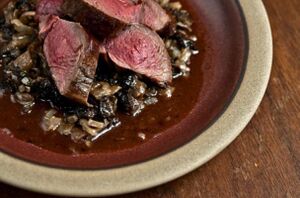
The Vithinjan meatball has developed to have a huge variety of local recipes for how to make it, with significant differences in the use of spices (mostly herb-based ones), meat mixtures (usually today one wild and one cattle) as well as heating method (grilled, oven-cooked, even a few examples of baked).

Holidays
Despite celebrating holidays like Christmas and Easter unlike most catholic nations vithinjans have incorporated their old pagan traditions into these holidays.


On top of that vithinjans also celebrate some of their own holidays. First of these holidays is Midsummer, which takes place during solstice. Earlier in the year, about a month before Easter, the Farewell takes place. At the start of fall the Union is celebrated.
For non-religious holidays vithinjans celebrate their national day on December the 14th. Although some consider this day to be religious, being a celebration of Rolv I ascension into Sainthood. Additionally the Syndicalization is celebrated on May the 3rd.
}}
